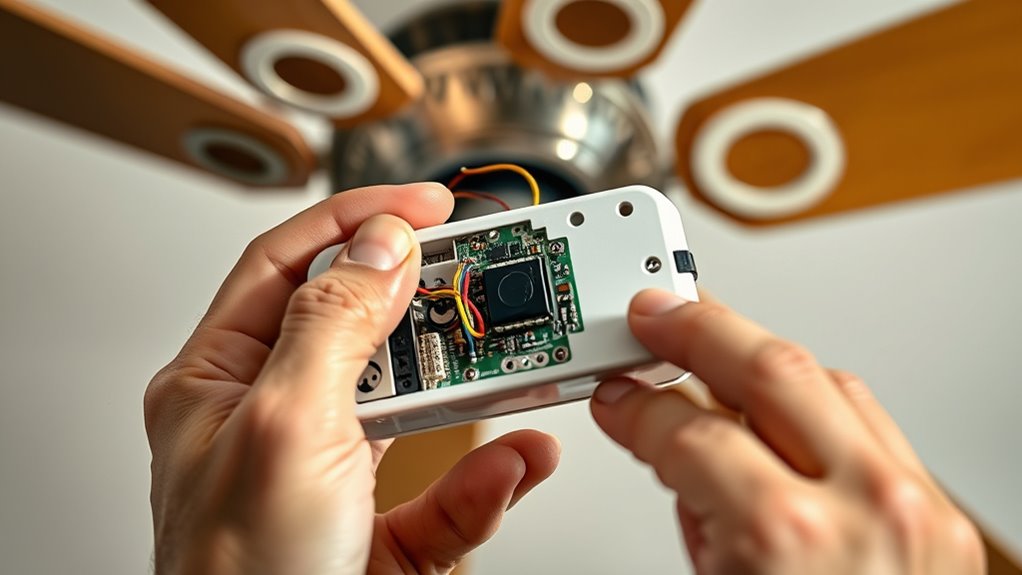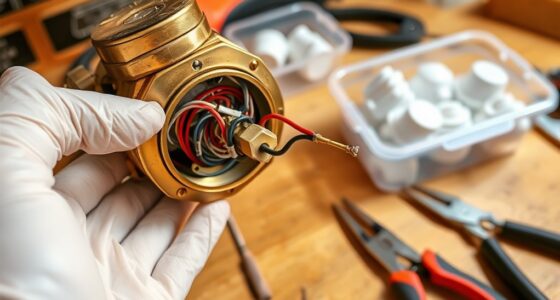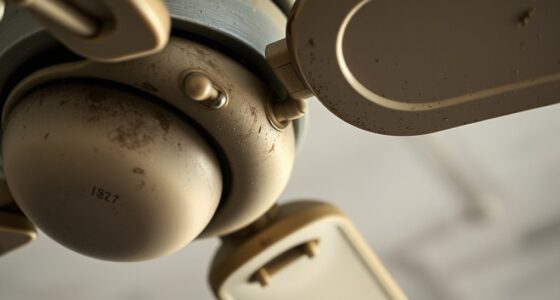To fix ceiling fan remote control problems, start by replacing old batteries with fresh, high-quality alkaline ones, ensuring proper polarity. Next, verify the remote’s pairing with the fan by following the manufacturer’s reset and synchronization steps, and confirm signals using a smartphone camera. Check the receiver unit for loose wiring or damage, and clean contacts if needed. Environmental interference may also affect performance; minimizing obstacles can help. For persistent issues, more detailed troubleshooting techniques can reveal the root cause.
Key Takeaways
- Replace old or depleted batteries with fresh, high-quality alkaline batteries and verify correct polarity.
- Ensure proper remote and fan pairing by following the manufacturer’s reset and programming procedures.
- Use a smartphone camera to check if the remote’s IR or RF signals are transmitting correctly.
- Inspect the fan receiver for loose wiring, corrosion, or physical damage, and secure or clean connections.
- Reduce environmental interference or consider replacing the remote or receiver if troubleshooting persists.

Experiencing issues with your ceiling fan remote control can disrupt comfort and convenience, but many problems are fixable with straightforward troubleshooting. The first step involves confirming the remote’s power source. Replace the batteries with fresh, high-quality alkaline batteries, ensuring correct polarity. Low or depleted batteries are a common cause of remote malfunctions, and using old or incompatible batteries can result in inconsistent signals. Once you’ve replaced the batteries, test the remote’s functionality by attempting to operate the fan from a short distance. If the fan responds, the issue was likely battery-related; if not, proceed with further diagnostics.
Next, ensure the remote is properly paired with the ceiling fan. Many remote control systems require initial pairing via a specific sequence, often involving pressing a combination of buttons on the remote and the fan’s receiver. Consult your fan’s user manual for precise instructions, as procedures vary among brands and models. Improper pairing can prevent the remote from transmitting signals correctly, leading to unresponsiveness or intermittent operation. If pairing is unsuccessful, reset both the remote and the fan’s receiver. This often involves turning the fan off at the circuit breaker, waiting several minutes, and then restarting it to clear previous settings.
Ensure proper pairing between remote and fan by following specific instructions from your user manual.
Another critical aspect involves verifying the remote’s signal transmission. Use a smartphone camera to check if the remote’s IR LED or RF transmitter emits signals when buttons are pressed. Point the remote at the camera lens and press the power button; if the LED flashes visibly on the camera screen, the remote is transmitting signals. If no signals are detected, the remote’s internal transmitter may be faulty, necessitating repair or replacement. Conversely, if signals are emitted but the fan does not respond, the problem may reside within the fan’s receiver or control module.
Inspect the fan’s receiver unit, typically located in the canopy or mounting bracket. Check for loose wiring, corrosion, or damage. Secure any loose connections and clean corrosion with a contact cleaner if necessary. Confirm that the receiver’s dip switches or programming settings align with those on the remote; mismatched settings can prevent communication. In some cases, reprogramming or resetting the receiver may resolve communication issues. If the receiver is damaged beyond repair, replacing it with an identical model ensures compatibility.
Finally, consider environmental factors that could interfere with remote signals. Wireless interference from other electronic devices, thick walls, or metal enclosures can impair signal transmission. Moving the remote closer to the receiver or removing sources of interference might restore proper operation. Additionally, replacing the remote with a compatible model can be a practical solution if all troubleshooting steps fail. If all troubleshooting steps fail, replacing the remote control or the fan’s receiver module becomes necessary. By systematically diagnosing each component—batteries, pairing, signal transmission, receiver condition—you can efficiently identify and resolve common ceiling fan remote control problems, restoring ideal functionality with minimal downtime.
Frequently Asked Questions
Can I Replace My Ceiling Fan Remote Control Myself?
Yes, you can replace your ceiling fan remote control yourself if you follow proper safety procedures. First, turn off the power at the breaker to avoid electrical shock. Remove the existing remote and battery pack, then disconnect the wiring carefully. Connect the new remote’s wiring according to the manufacturer’s instructions, secure all connections, and restore power. Test the remote to verify it controls the fan functions correctly.
What Should I Do if the Remote’s Batteries Are New but Not Working?
If your remote’s batteries are new but still don’t work, you need to troubleshoot further. First, check for any obstructions or interference between the remote and the receiver. Confirm the remote’s IR sensor isn’t blocked or dirty; clean it gently with a soft cloth. Reprogram the remote if needed, or replace it if the internal circuitry is faulty. Double-check connections and consider resetting the remote by removing batteries for a few minutes.
How Do I Reprogram My Ceiling Fan Remote Control?
To reprogram your ceiling fan remote, first locate the “Program” or “Setup” button on the remote or receiver. Press and hold this button until the LED indicator flashes, then release it. Within 30 seconds, press the desired fan speed button to establish the new connection. Confirm the reprogramming by testing the remote controls the fan functions correctly. If unsuccessful, repeat the process or consult the manufacturer’s instructions.
Is It Safe to Use Third-Party Remote Controls?
Using third-party remote controls can be safe if they meet your fan manufacturer’s specifications, but always verify compatibility first. Confirm the remote adheres to the same frequency and communication protocols to prevent malfunctions or damage. Poorly designed or incompatible remotes risk causing electrical issues, voiding your warranty, or damaging your fan’s receiver. Always choose reputable brands, follow installation instructions carefully, and consult your fan’s manual to guarantee safety and ideal performance.
How Can I Prevent My Remote From Losing Signal?
To prevent your remote from losing signal, verify the batteries are fresh and properly installed. Keep the remote within the recommended range, typically 20-30 feet, and avoid obstructions like furniture or metal objects between the remote and receiver. Regularly clean the remote’s infrared sensor with a soft cloth and check for any damage. Reprogram the remote if necessary, and avoid interference from other electronic devices operating on similar frequencies.
Conclusion
By troubleshooting your ceiling fan remote, you’re fundamentally reprogramming the heartbeat of your cooling system. Ensuring batteries are fresh, resetting the remote, or checking the receiver aligns your fan’s operation like gears in a finely tuned machine. When you follow these precise steps, you restore seamless control, preventing minor glitches from escalating into major disruptions. Think of it as tuning a musical instrument—once calibrated correctly, your fan will perform smoothly, keeping your space comfortably cool with a simple command.









